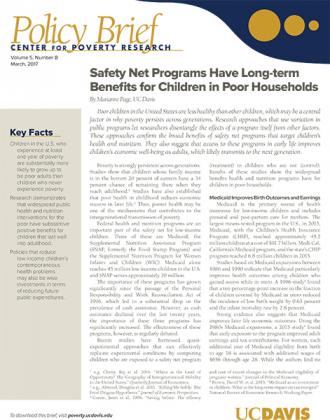Safety Net Programs Have Long-term Benefits for Children in Poor Households
By Marianne Page, UC Davis
Poor children in the United States are less healthy than other children, which may be a central factor in why poverty persists across generations. Research approaches that use variation in public programs let researchers disentangle the effects of a program itself from other factors. These approaches confirm the broad benefits of safety net programs that target children’s health and nutrition. They also suggest that access to these programs in early life improves children’s economic well-being as adults, which likely transmits to the next generation.
Poverty is strongly persistent across generations. Studies show that children whose family income is in the bottom 20 percent of earners have a 34 percent chance of remaining there when they reach adulthood.[1] Studies have also established that poor health in childhood reduces economic success in later life.[2] Thus, poorer health may be one of the mechanisms that contributes to the intergenerational transmission of poverty.
Key Facts
- Children in the U.S. who experience at least one year of poverty are substantially more likely to grow up to be poor adults than children who never experience poverty.
- Research demonstrates that widespread public health and nutrition interventions for the poor have substantive positive benefits for children that last well into adulthood.
- Policies that reduce low-income children’s contemporaneous health problems may also be wise investments in terms of reducing future public expenditures.
Federal health and nutrition programs are an important part of the safety net for low-income children. Three of these are Medicaid, the Supplemental Nutrition Assistance Program (SNAP, formerly the Food Stamp Program) and the Supplemental Nutrition Program for Women Infants and Children (WIC). Medicaid alone reaches 45 million low income children in the U.S. and SNAP serves approximately 20 million.
The importance of these programs has grown significantly since the passage of the Personal Responsibility and Work Reconciliation Act of 1996, which led to a substantial drop in the prevalence of cash assistance. However, as cash assistance declined over the last twenty years, the importance of these three programs has significantly increased. The effectiveness of these programs, however, is regularly debated.
Recent studies have harnessed quasi-experimental approaches that can effectively replicate experimental conditions by comparing children who are exposed to a safety net program (treatment) to children who are not (control). Results of these studies show the widespread benefits health and nutrition programs have for children in poor households.
Medicaid Improves Birth Outcomes and Earnings
Medicaid is the primary source of health insurance for low-income children and includes prenatal and post-partum care for mothers. The largest means-tested program in the U.S., in 2015, Medicaid, with the Children’s Health Insurance Program (CHIP), reached approximately 45.2 million children at a cost of $91.7 billion. Medi-Cal, California’s Medicaid program, and the state’s CHIP program reached 6.8 million children in 2015.
Studies based on Medicaid expansions between 1986 and 1990 indicate that Medicaid particularly improves health outcomes among children who gained access while in utero. A 1996 study[3] found that a ten-percentage-point increase in the fraction of children covered by Medicaid in utero reduced the incidence of low birth weight by 0.63 percent and the infant mortality rate by 2.8 percent.
Strong evidence also suggests that Medicaid improves later life economic outcomes. Using the 1980s Medicaid expansions, a 2015 study[4] found that early exposure to the program improved adult earnings and tax contributions. For women, each additional year of Medicaid eligibility from birth to age 18 is associated with additional wages of $656 through age 28. While the authors find no wage improvements for men, they do find that an additional year of Medicaid eligibility is associated with a $127 increase in men’s tax payments by age 28. For women, the comparable effect is $247.
SNAP Improves Birth Outcomes and Health
SNAP is a food assistance program provided for individuals (including adults) living in households with income below 130 percent of the poverty guideline. It provides vouchers that can be used to purchase most types of food in grocery stores or other retailers. The average monthly benefit in 2014 was $257 per household, or $125 per person.[5] In 2015 SNAP benefits were provided to 45.8 million individuals. Approximately 20 million of these were children. Under the Cal-Fresh program in California, over two million children receive benefits each year.
Recent studies show that SNAP improves children’s short- and long-term well-being. A 2011 study[6] compared birth outcomes among children born in counties that were early adopters of the Food Stamp program to those in counties that adopted a few years later. Among all families who received Food Stamps, the incidence of low birth weight was about seven percent lower for White infants and about three percent lower for Black infants.
Using the same approach with longitudinal panel data, a 2016 study[7] found that children who were fully exposed to Food Stamps during the first five years of life experienced a 0.3 standard deviation reduction in later life “metabolic syndrome” (e.g. obesity, high blood pressure, heart disease, diabetes). The study also estimates that disadvantaged girls with full access to the program from conception to age five were 0.2 standard deviation more likely to be financially self-sufficient in adulthood than those who did not.
WIC and Longer-term Health Improvements
The WIC program targets pregnant women as well as children under the age of five who are considered to be at nutritional risk. Recipients must have a household income below 185 percent of the poverty guideline or participate in the TANF or SNAP programs. WIC benefits specify foods with high levels of protein, calcium, iron and other specific vitamins. In 2014, WIC benefits reached just under two million women and 6.3 million children at a total cost of $6.3 billion.[8] Approximately 285,000 women and 980,000 children received benefits in California during 2015 at a cost of $1 billion.
In a 2011 study,[9] my co-authors and I used variation across counties in the timing of the program’s initial implementation. We merged data on county-by-county implementation with measures of infant health from U.S. Vital Statistics Natality Files. We found that when WIC is available by the third trimester, the average birth weight among infants born to women with low levels of education increases by approximately seven grams. The probability of being born below the low birth weight threshold also falls by 1.4 percent.
A 2013 study[10] extended this research design to 2005-09 cohorts using Vital Statistics health data and administrative data on all Texas WIC clinics. This study found WIC to be associated with an average increase in birth weight of 27 grams. It also found a six percent increase in breastfeeding among women with a high school diploma or less. Given the positive linkages between breastfeeding and later health,[11] this finding suggests longer-term health improvements for these children.
Reducing Poverty for Future Generations
The existing body of research makes clear that large-scale public health and nutrition interventions provide far reaching benefits for poor children, though these improvements will not be apparent in an official poverty measure based entirely on household cash income. Nevertheless, because these programs improve adult health, earnings and overall self-sufficiency, they are crucial levers to reducing the intergenerational transmission of poverty.
These policies may also reduce future public expenditures. Using Medicaid Statistical Information System data a recent study[12] estimated that the 1980s and 1990s expansions will lead the government to recoup at least 56 cents of each $1 spent on childhood Medicaid by the time the affected children reach age 60. This estimate does not take into account government savings that accrue after age 60, nor do they include any savings in health care costs as a result of individuals’ improved health.
Marianne Page is a professor of economics at UC Davis and deputy director of the Center for Poverty Research.
[1] e.g. Chetty, Raj et al. 2014. “Where is the Land of Opportunity? The Geography of Intergenerational Mobility in the United States.” Quarterly Journal of Economics.
[2] e.g., Almond, Douglas et al. 2011. “Killing Me Softly: The Fetal Origins Hypothesis.” Journal of Economic Perspectives.
[3] Currie, Janet et al. 1996. “Saving babies: The efficacy and cost of recent changes in the Medicaid eligibility of pregnant women.” Journal of Political Economy
[4] Brown, David W. et al. 2015. “Medicaid as an investment in children: What is the long-term impact on tax receipts?” National Bureau of Economic Research Working Paper.
[5] Hoynes, Hilary et al. 2015. “U.S. food and nutrition programs.” Forthcoming in Means-Tested Transfer Programs in the United States, Robert A. Moffitt, ed., University of Chicago Press.
[6] Almond, Douglas et al. 2011. “Inside the war on poverty: The impact of food stamps on birth outcomes.” The Review of Economics and Statistics.
[7] Hoynes, Hilary et al. 2016. “Long-run impacts of childhood access to the safety net.” The American Economic Review.
[8] Hoynes et al., 2015.
[9] Hoynes, Hilary et al. 2011. “Can targeted transfers improve birth outcomes?: Evidence from the introduction of the WIC program.” Journal of Public Economics.
[10] Rossin-Slater, Maya. 2013. “WIC in your neighborhood: New evidence on the impacts of geographic access to clinics.” Journal of Public Economics.
[11] Eidelman, Arthur, et al. 2012. “Section on breastfeeding. American Association of Pediatrics Policy statement: breastfeeding and the use of human milk.” Pediatrics.
[12] Brown, David, et al. 2015. “Medicaid as an investment in children: What is the long-term impact on tax receipts?” National Bureau of Economic Research Working Paper.
#povertyresearch











